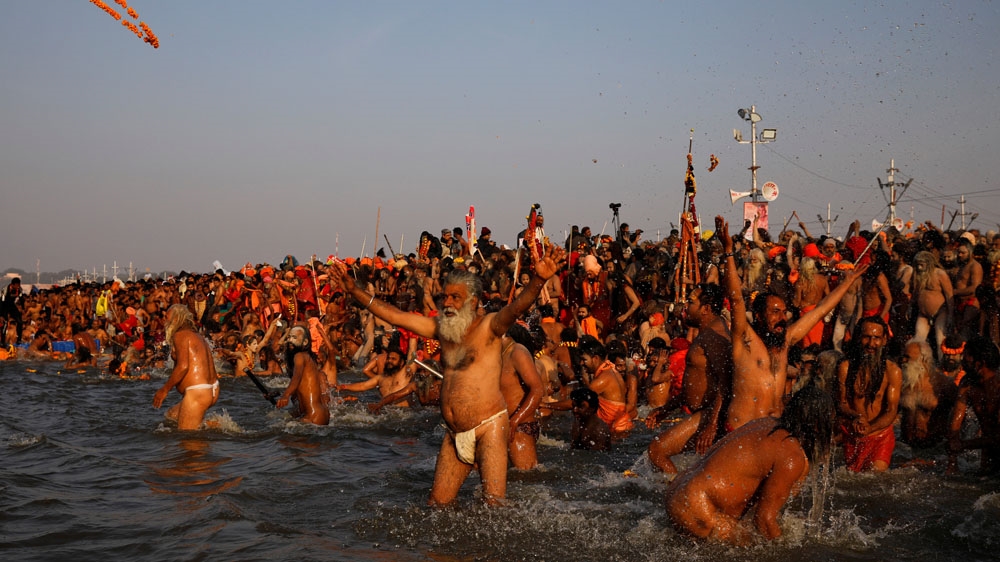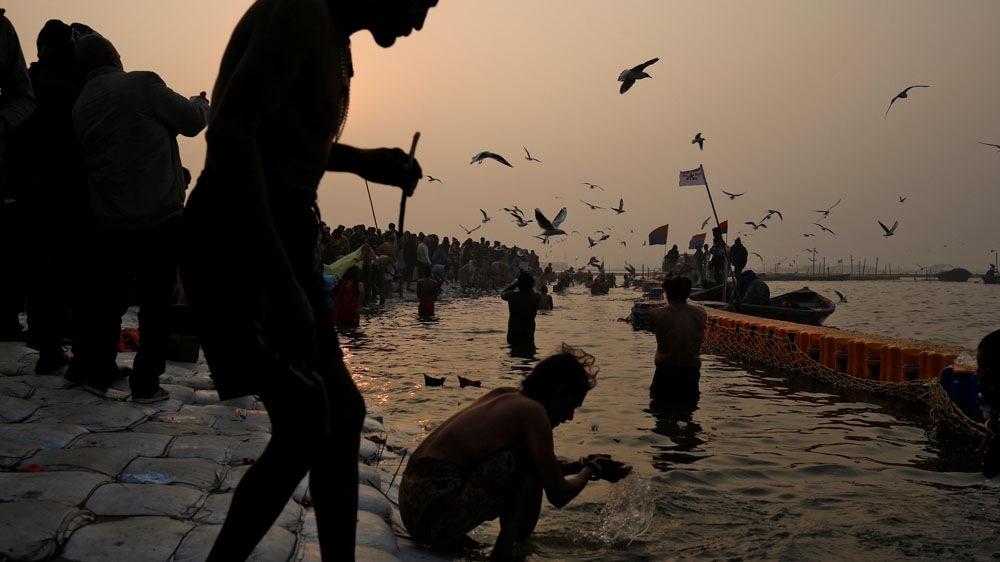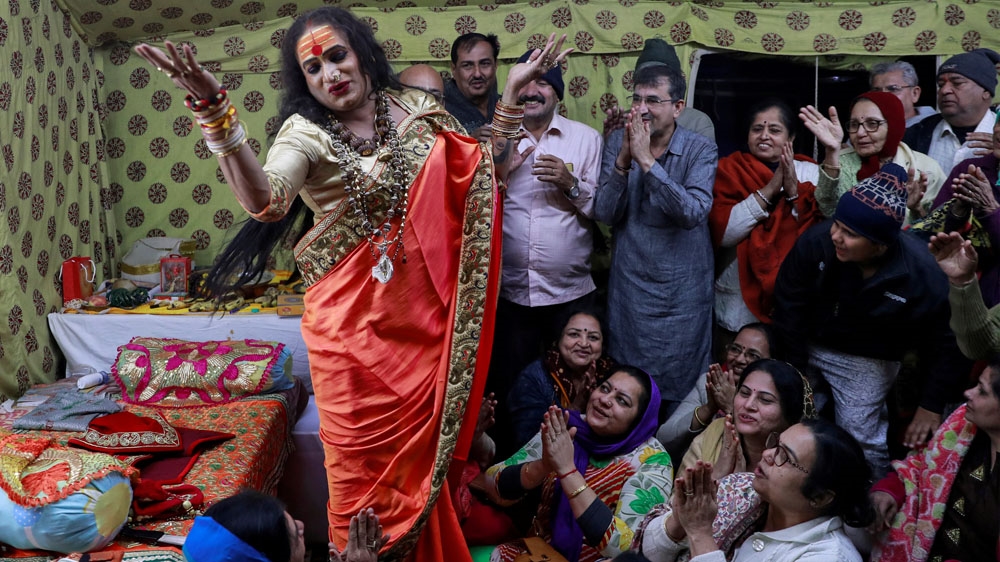India’s mega Kumbh festival gets a BJP boost ahead of election
New Delhi, India – Over a hundred million people will be taking a holy dip at the confluence of two rivers in northern India‘s Prayagraj city as the eight-week long Kumbh festival began on Tuesday.
The Kumbh, billed as the world’s biggest gathering of humanity, is a mass pilgrimage in which Hindus gather in specific locations along the holy rivers Ganges, Yamuna and the mythical river Saraswati for a holy dip that they believe will cleanse their sins and bring salvation.
The religious event in the Uttar Pradesh state, which will continue till March 4, is being organised by the right-wing governments at both the federal and state levels in an election year.
Astrology determines most aspects of the UNESCO-listed festival, including its exact date and length. Where the festival will be held depends on the position of Jupiter, the sun and earth.
‘Exhilarating experience’
“It is an exhilarating experience. To be part of a sea of humanity that arrives to take a dip in the holy waters, it is humbling and joyful. You abandon your fears at the Kumbh and hopefully your sins,” Gopal Mishra, a devout Hindu who has been to the festival several times, told Al Jazeera.
There are six particularly auspicious days to bathe. The biggest bathing day is February 4, when approximately 30 million people are expected to take to the waters.
The first such Shahi Snan, or Royal Bath, began before dawn on Tuesday.
 |
| ‘Naga Sadhus’ taking a dip during the first ‘Shahi Snan’ at the Kumbh [Danish Siddiqui/Reuters] |
“Teams will be managing crowds on the river bank. All roads leading to the Kumbh Mela grounds will be packed with hundreds of thousands of pilgrims in the coming days,” Bimlesh Kumar, a senior official at the government tourism department told Al Jazeera.
“We are expecting around 120 million people, and an additional two million foreign visitors this year. The festival will continue for 49 days. An average two million people are likely to take a dip everyday,” he added.
Prayagraj city had been preparing for the festival for months as the government built communal areas with 20,000 beds and a tented city with 4200 “premium” tents around the river.
According to a report, the Bharatiya Janata Party (BJP)-led federal and state governments are spending over $620m, more than triple the public money spent in 2013 on the same event.
The government says 116 roads have been constructed and 524 shuttle buses deployed to transport the pilgrims. More than 1,22,000 toilets have been built for the attendees.
On Tuesday, Indian Prime Minister Narendra Modi tweeted to say he hoped visitors to this year’s Kumbh would “experience India’s spiritual, cultural and social diversities”.
प्रयागराज में आरंभ हो रहे पवित्र कुम्भ मेले की हार्दिक शुभकामनाएं।
मुझे आशा है कि इस अवसर पर देश-विदेश के श्रद्धालुओं को भारत की आध्यात्मिक, सांस्कृतिक एवं सामाजिक विविधताओं के दर्शन होंगे।
मेरी कामना है कि अधिक से अधिक लोग इस दिव्य और भव्य आयोजन का हिस्सा बनें। pic.twitter.com/qAxJtNrUPn
— Narendra Modi (@narendramodi) January 15, 2019
Election year mega event
The relentless promotion of Kumbh by the ruling BJP coincides with the general elections slated to be held in a few months.
The BJP’s recent electoral losses in five Indian states last month have shown a dip in Modi’s popularity.
The ruling party is making renewed appeals to its hardcore Hindu nationalist base in Uttar Pradesh, India’s most politically important state, which is hosting this year’s Kumbh.
Ahead of the Kumbh gathering, BJP leader and Uttar Pradesh Chief Minister Adityanath changed the name of the historical city of Allahabad to the more “Hindu” sounding Prayagraj.
The BJP has also announced the construction of a giant statue of Hindu diety Ram in the state.
In contrast, state police in Uttar Pradesh are cracking down on Muslims praying in open areas like parks.
Earlier in 2018, the Indian government also announced the end of a decades-long policy of giving subsidy to thousands of Muslims heading to the holy city of Mecca to perform the annual Hajj pilgrimage.
Uttar Pradesh, India’s most populous state with 200 million people, sends 80 lawmakers to India’s lower house of parliament, the reason it is a politically crucial state.
Opposition parties say the government is trying to hide its failures in governance, and is promoting itself in the media instead of the Kumbh festival.
Images of Modi and Adityanath are splashed on Kumbh promotional billboards across Prayagraj city.
“Kumbh is not a substitute for effective governance. The BJP party often behaves like a publicity and marketing company. This holy festival has always been organised by the government. But money was never spent such lavishly solely for advertisements of the government,” Akhilesh Pratap Singh, national spokesperson of the Congress party in Lucknow, told Al Jazeera.
“At the moment, people want answers from them. Where are the jobs for our youth, safety for women, rule of law, industry? It’s not possible for them to deflect attention from their governance failures anymore,” he added.
 |
| Devotees take a holy dip at Sangam, the confluence of the Ganges, Yamuna and mythical Saraswati rivers [Danish Siddiqui/Reuters] |
The Kumbh has been marred several times by stampedes. Over 800 people were killed in 1954, 40 died in Nashik western India in 2003, while 36 people died in the 2013 gathering at Allahabad.
On Monday, a small fire broke out at one of the camps although no casualties were reported.
Kumbh for electoral gains?
Hindu religious belief says that in a fight over an urn between the gods and the demons, a few drops of the essence of immortality spilled on to four places on earth, which now host the Kumbh, one of which is Prayagraj.
There are three different kinds of Kumbh: an Ardha (or half) Kumbh held every six years at two locations, a Purna (or full) Kumbh every 12 years at four locations, and a Maha Kumbh that happens every 144 years or after 12 Purna Kumbhs.
Critics of the Modi government say a half Kumbh is being given unprecedented prominence this time and there is a conscious attempt to boost support for events that reinforce Hindu symbols appealing to the BJP’s Hindu nationalist support base.
India’s 1.3 billion people are about 80 percent Hindu and appeals to religion or caste are deeply ingrained in Indian politics.
A report by investigative magazine Caravan last month said the BJP’s ideological mentor, the Rashtriya Swayamsevak Sangh (RSS), is attempting to drum up support for the government using the Kumbh ahead of the elections.
Hindu supremacist groups such as the RSS and the Vishwa Hindu Parishad (VHP) are clamouring for a government order to bypass the Supreme Court in order to build a Ram temple at Ayodhya city in Uttar Pradesh.
In 1992, a Hindu mob tore down a medieval mosque, which they claim stood at a contested site believed to be the birthplace of Ram.
“Right from the Babri mosque demolition, the right-wing in India always uses religious congregation to promote Hindutva or a militant radical strain of Hinduism backed by the current ruling party. Previous Kumbh festivals from the mid-1980s onwards have been fertile ground for making political demands,” Nilanjan Mukhopadhyay, a political analyst in New Delhi, told Al Jazeera.
But the ruling BJP denies any political overtones to the festival.
“It is a sacred and auspicious time for Hindus. Kumbh has a special place in not just the religious but cultural life of Indians. Every government irrespective of ideology has been organising this festival at a mega scale,” Sudhanshu Mittal, spokesperson of the ruling BJP, told Al Jazeera.
 |
| Lakshmi Narayan Tripathi of the ‘Kinnar Akhara’ congregation for transgender people, dances and sings with followers at Kumbh [Danish Siddiqui/Reuters] |
On January 31 and February 1, a Dharam Sansad (religious assembly) will be held at the Kumbh by the VHP, one of the many far-right Hindu groups linked to Modi’s BJP party.
On the opening day of the festival, Indian media reported slogans of “Modi, you lead the fight, we are with you” and “The temple will be built in Ayodhya” being raised on loudspeakers amid religious Hindu chants.
The idea is to use Kumbh as a rallying point, says Akshaya Mukul, author of “Gita Press and the Making of Hindu India”.
“In the times of divided polity and an election year, a Hindu nationalist party like BJP will definitely extract political mileage out of it. Social media is abuzz with videos praising the BJP for its arrangements. Apparently never before has a state administration worked so hard,” Mukul told Al Jazeera.
“It is ironic that in a state where infants die for the lack of oxygen, arrangement of a religious fair is seen as a marker of good administration,” he said, referring to a 2017 tragedy in which more than 60 infants died for lack of oxygen in a state-run hospital in Uttar Pradesh due to unpaid bills.
“The BJP will use this year’s Kumbh to the hilt and maximise benefits. It remains to be seen if it succeeds or not since it has failed in fulfilling its basic promises of jobs, education and health,” said Mukul.




